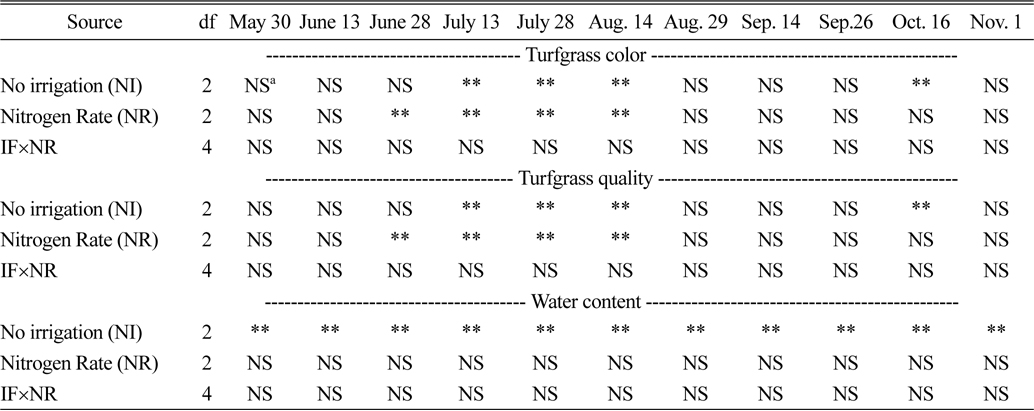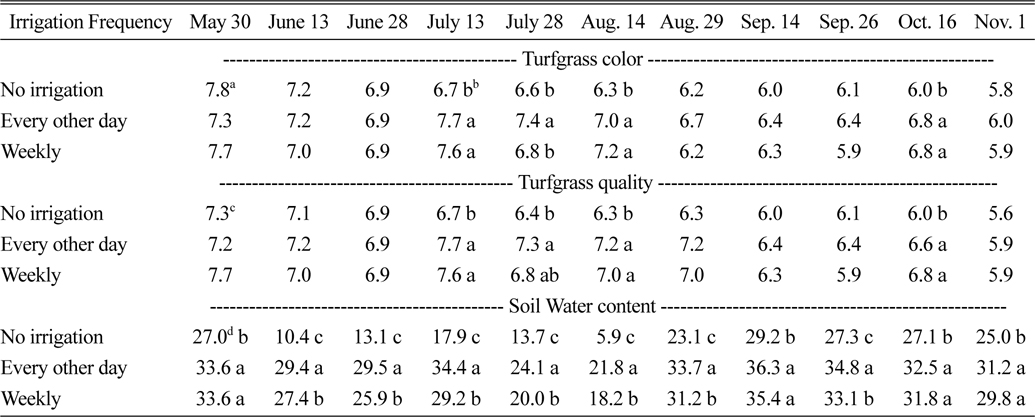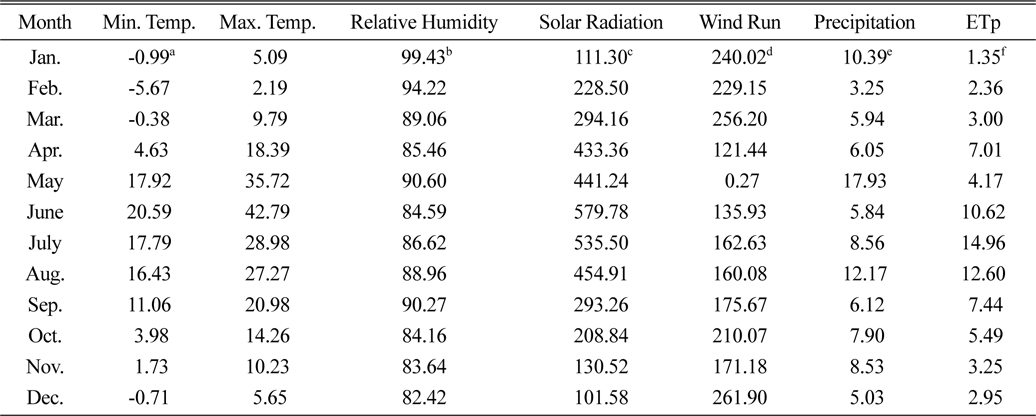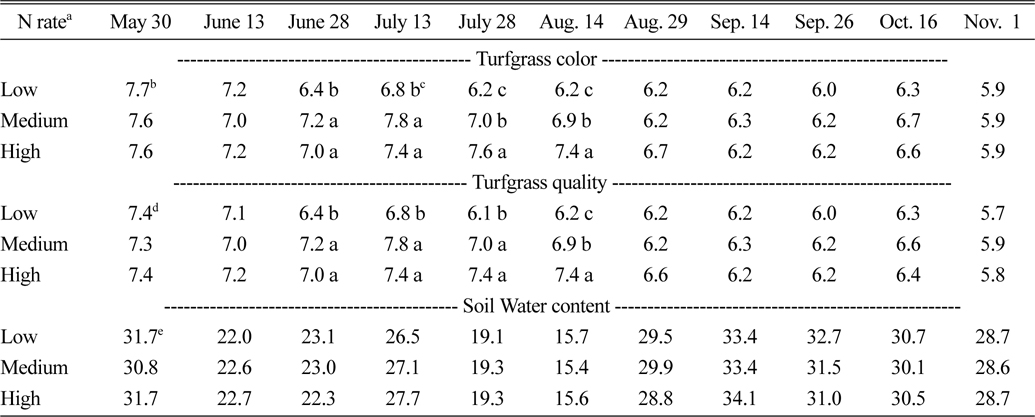



Tall fescue (
The effects of irrigation frequency on turf responses have been investigated in both cool-season and warm-season grass species (Cereti et al., 2009). Fry and Huang (2004) defined deep and infrequent irrigation as irrigation to provide water for root zone just before the time when the first signs of leaf wilt appear. In general, deep and infrequent irrigation refers to applying large amounts of irrigation, 1.3 to 2.5 cm or more, in a single irrigation event. A number of researches have been done to support benefits of deep and infrequent irrigation. Madison and Hogan (1962) found better root growth with infrequent irrigation for warm-season grasses. Deeply and infrequently irrigated bentgrass produced higher levels of water soluble carbohydrate (Fu and Dernodeden, 2008). Jordan et al. (2003) investigated the responses of creeping bentgrass (
Nitrogen (N) use for turfgrass management is often unnoticed for water management. High N applications typically resulted in increased shoot growth, which leads to increased water use. Campbell (1977) investigated that high rates of N applied to spring wheat under semi-arid conditions induced rapid growth of leaves and roots which lead to increase the rate of ET and the depletion of limited soil moisture. There are gaps in research results regarding the interaction of irrigation frequency and N rates for appropriate quality of tall fescue. The primary objective of the study was to evaluate the effects of irrigation frequency and N rates for tall fescue growth.
Research was initiated at the Hancock Turfgrass Research Center on the campus of Michigan State University in East Lansing, Michigan. Each plot size for the study was 3.7 by 3.7 m. Irrigation frequency and N rate treatments were initiated on tall fescue on 25 April 2006. Three irrigation treatments were no irrigation (precipitation only), 0.5 cm applied every other day, and 1.8 cm applied weekly at one irrigation event. All irrigation treatments were applied at 6:00 a.m. The treatment list and application timing are listed in Table 1. The nitrogen (N) treatments were 9.8, 15.6, and 20.8 g N m-2 yr-1 for the low, medium, and high N rate treatments, respectively. The low, medium, and high N treatments were applied over 2, 4, and 6 applications, respectively. Nitrogen was applied using a mixture of sulfur coated urea (SCU) and urea at a ratio of 25% SCU to 75% urea. The potassium (K) applied from muriate of potash (0-0-60) at a ratio of 2:1 (N:K) for all treatments was applied. There was no phosphorus treatment for the study. All fertilizers were granular type and applied using a drop fertilizer spreader (Gandy 24H13, Gandy Company). Immediately following each fertilizer application, 1.3 cm of irrigation was applied. The turfgrass was mowed weekly and clippings returned to the plots.
[Table 1.] Treatment list and nitrogen application plan.

Treatment list and nitrogen application plan.
Seasonal turf color ratings are a measure of overall plot color (NTEP, 2011). Turfgrass color was measured by an index of damage caused by disease or insect pests, nutrient deficiency or environmental stress. Turfgrass color was visually rated on a scale of 1 to 9 (1 = straw brown, 6 = acceptable, and 9 = dark green) every two weeks. Turfgrass quality was measured by an index of turf density, leaf texture, disease resistance, mowing qualities, and stress tolerance including several stresses during winter (Beard, 1973; Turgeon, 1999). Turfgrass quality was visually rated on a scale of 1 to 9 (1 = poor, 6 = acceptable, and 9 = best) every two weeks. Turfgrass clippings were collected every two weeks from each plot, dried at 67 °C for 48 hours and weighed. Volumetric water content (%) in the soil was measured at the depth of 12 cm every two weeks by Time Domain Reflectometry (Field Scout TDR-300, Spectrum Technologies). The experimental design was a randomized complete-block design with three replications. Analysis of variance (ANOVA) was performed on transformed data using Statistical Analysis Systems design (SAS Institute Inc., 2001).
There was no significant irrigation frequency by nitrogen (N) rate interaction for throughout the study (Table 2). There were significant irrigation frequency main effects for turfgrass color. Significant differences among irrigation frequency treatments for turfgrass color were found from July 13 to Aug. 14 and Oct. 16 (Table 3). The treatment of no irrigation had the lowest turfgrass color during the study when significant difference for irrigation frequency main effects was found on turfgrass color. The no irrigation had turfgrass color greater than acceptable turfgrass color rating of six during the study except the Nov. 1. No significant differences were found between every other day and weekly irrigation except July 28. Every other day had greater turfgrass color than weekly irrigation on July 28. In July, the amount of precipitation was 6.4 cm lower than ET (Table 8). When ET is higher than precipitation without additional irrigation, irrigation frequency is effective for turfgrass color based on the result of this study. There were significant irrigation frequency main effects for turfgrass quality (Table 3). Similar to turfgrass color, weekly and every other day irrigation treatments had the highest or equal to the highest turfgrass quality ratings when significant differences were found. All of the irrigation treatments had turfgrass quality ratings greater than the acceptable rating of six throughout the research except Nov.1. Although tall fescue is one of cool-season grasses, its poor cold tolerance is well-known (Christians, 2004). According to Beard (1973), appropriate temperature ranges are 18 to 24℃ for shoots and 10 to 18℃ for roots of cool-season grasses. Fry and Huang (2004) reported that the lethal temperature for hardened cool-season grasses is -5℃. The minimum and maximum temperature at November, 2006 was 1.73 and 10.23℃, respectively which is out of temperature range for cool-season grass growth. There were significant irrigation frequency main effects for turfgrass soil water content (Table 3). The no irrigation had the lowest soil water content throughout the research. Every other day had greater soil water content than weekly irrigation on 7 of 11 rating dates, and in these sampling dates ET was higher than precipitation. The no irrigation had the lowest turfgrass color and quality with the lowest soil water content. However, the no irrigation had turfgrass color and quality greater than acceptable ratings of six throughout the research except Nov. 1. Overall, every other day and weekly irrigation had no significant difference. Visual quality of tall fescue subjected to irrigation frequency was not affected throughout the research.
[Table 2.] Analysis of variance for turfgrass color, quality, and soil water content.

Analysis of variance for turfgrass color, quality, and soil water content.

Mean turfgrass color, quality and soil water contents for irrigation frequency main effect.
[Table 8.] Weather data for 2006.

Weather data for 2006.
There were significant N rate main effects for turfgrass color (Table 4). The low N rate had the lowest turfgrass color when significant differences were found. Although the low N rate had the lowest turfgrass color throughout the research, the low N rate had turfgrass color greater than acceptable turfgrass color rating of six except Nov. 1. Significant differences between the medium and high N rate on July 28 and Aug. 14 were found. The high N rate had the highest or equal to the highest turfgrass color throughout the research. There were significant N rate main effects for turfgrass quality (Table 4). The high N rate had the highest or equal to the highest turfgrass quality. The low N rate had the lowest turfgrass quality when significant differences were found. For the soil water content, no significant differences for N rates were found. For clipping dry weight, no interaction between irrigation and N rate was found (Table 5). There are irrigation frequency main effects for clipping dry weight b in July and August (Table 6). The no irrigation had the lowest clipping dry weight throughout the study. For total amount of clipping dry weight, no differences between every other day and weekly irrigation was found. Every other day irrigation had 25.5% more clipping dry weight than weekly irrigation in July. Clipping dry weight in July was 141.5% more than clipping dry weight in August. Su et al. (2007) investigated the effects of high temperature and drought on a hybrid bluegrass compared with Kentucky bluegrass and tall fescue, and they found high temperatures decreased clipping yield at 35/25℃ (14-h day/10-h night) in tall fescue by 38% when compared to 22/15℃ (14-h day/10-h night) temperatures. In the study, the maximum temperature in July was 28.9℃ and 27.3℃, respectively. Under the condition, the irrigation frequency of every other day is more effective than weekly irrigation for shoot growth of tall fescue. There were significant N rate main effects for clipping dry weight (Table 7). The low N rate had the lowest clipping dry weight when significant differences were found. The low N rate treatment with two applications spaced four months apart would not be recommended if maintaining consistent turfgrass color and quality is important throughout the growing season. Applying lower amounts of N on a more frequent basis may result in more consistent growth and quality responses than observed from our two applications of 4.9 g N m-2 spaced four months apart. In the study, the low N rate had turfgrass quality greater than acceptable turfgrass quality of six for the growing season. The medium and high N rate had the highest clipping dry weight except in July. The medium N rate had 31.7% more clipping dry weight than the high N rate. The abundant researches have been reported that more N application increase more shoot growth. In the study, shoot growth was influenced by irrigation frequency than N rate especially under high ET condition and high temperature.
[Table 4.] Mean turfgrass color, quality and soil water contents for nitrogen rate main effect.

Mean turfgrass color, quality and soil water contents for nitrogen rate main effect.
[Table 5.] Analysis of variance for clipping dry weight.

Analysis of variance for clipping dry weight.
[Table 6.] Mean turfgrass clipping dry weight for irrigation frequency main effect.

Mean turfgrass clipping dry weight for irrigation frequency main effect.
[Table 7.] Mean turfgrass clipping dry weight for nitrogen rate main effect.

Mean turfgrass clipping dry weight for nitrogen rate main effect.
Nitrogen effects on turfgrass color and quality have been reported from numerous researches. Bowman (2003) compared growth rate of perennial ryegrass treated with a daily or periodic N application schedule. When comparing a 32 d interval of N applications to an 8 and 16 d interval of N applications, the growth rate of was greatly reduced after 30 days with the 32 days interval of N application. However, the low N rate with two applications spaced 120 days had turfgrass quality greater than acceptable turfgrass quality rating of six for tall fescue in this study. Although irrigation frequency effects between every other day and weekly irrigation were not significant, every other day irrigation was more effective for turfgrass color and soil water content under high ET rate and temperature. If high main maintenance of tall fescue is not important and water source is limited, irrigation is not necessary and, the 9.8 g N m-2 yr-1 of two applications can be recommended for tall fescue under the weather condition of the study. If dark green and high turfgrass quality of tall fescue is required and ET rate is high, the 15.6 gNm-2 yr-1 of four applications and more frequent irrigation than weekly irrigation would be recommended.







